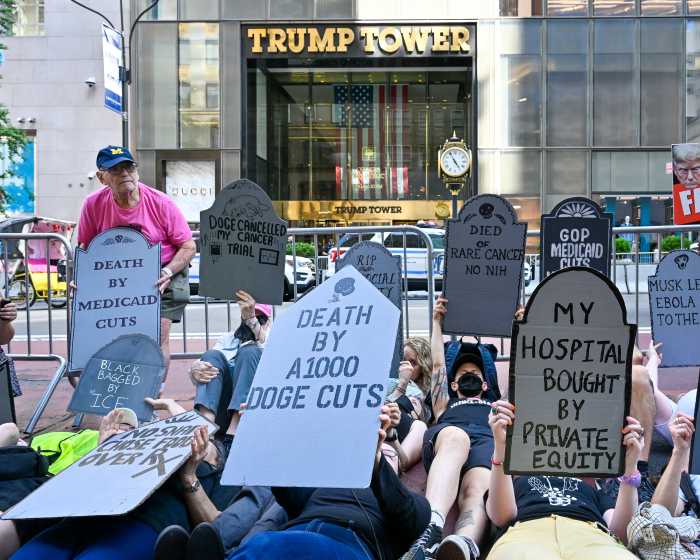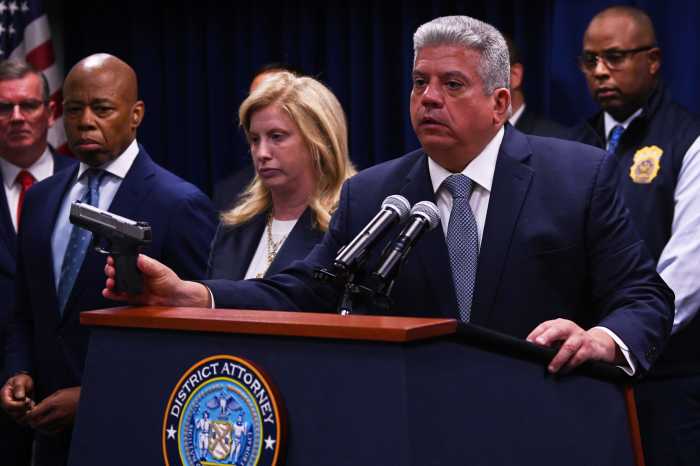
Cameras have been collecting data on vehicles and pedestrians on a two-block stretch of Fulton Mall in Downtown Brooklyn for at least the last six months.
They are part of a pilot program by startups that say they want to change the way New York City collects information on movement patterns.
At a showcase Thursday night at the New Lab — a tech "ecosystem" that boasts over 100 companies and 600 entrepreneurs, according to its website — in the Brooklyn Navy Yard, several companies presented their vision of what they called “The Circular City.” The program aims to tackle challenges in the urban environments including mobility, economic development and sustainability.
On a monitor, Tara Pham, the CEO of Numina, pointed to a flurry of green lines running down Fulton Street in addition to crossing to the other side in the middle of the sidewalk. The linear flurry represents pedestrian traffic that her company has tracked via four censors mounted on light poles.

“We do this path visualization so you can see, for example, there are bicycles riding on the sidewalk instead of the bike lane or there’s a lot of jaywalking in this type of area,” Pham said.
The screen also showed small red boxes tracking vehicles as they pass. Her company’s cameras can differentiate between cars, trucks and buses.
With the data that has been collected, Numina found that more than 80 percent of vehicles were turning onto Fulton Street from Flatbush Avenue. The censors were also able to identify 24 million objects in the six-month period.
Pham is hoping the city will adopt her system of automated counting rather than doing it manually.
“If you consider there are tens of thousands of pedestrians that go through any of these corridors a day, it’s just way more than a person can even keep up with,” Pham said. “And plus, people got to eat, sleep, blink. Our censors don’t have to do any of those things.”

Numina has also set up sensors in other cities including New Orleans, San Francisco, Toronto and Nijmegen in the Netherlands. And that’s what New Lab said it wants its companies to do. Shaina Horowitz, the urban tech hub director, has pushed to have these ideas go further than Downtown Brooklyn.
“These companies are global in their ambition. They really want to be active in cities around the world. In order to have global scale, you have to start at the neighborhood level and you have to [have] these cases and proof points,” Horowitz said.
Another startup that is part of the collective partnered with Toyota in January to produce high-definition maps for autonomous vehicles. CARMERA uses sensors on vehicles, map cars, people and objects on the road to ensure cars have the most up-to-date information.
Ro Gupta, the CEO of CARMERA, says they are able to measure down to tenths of centimeters. He says the city is a unique place to learn how to deal with variables such as construction and jaywalkers.
“If you can map midtown, you can map Mountain View,” said Gupta, referring to the city in California that is home to tech giant Google. “New York City is a great place to test the limits and do research and development.”

His company has also committed to voluntarily making its data available to the city. Jessie Lazarus, head of ecosystem business development at the company, said, without specifying any restrictions, it is also voluntarily making its data open to governments.
“This would be another tool in the tool box for Vision Zero,” said Lazarus, referring to Mayor Bill de Blasio’s campaign to reduce traffic fatalities. Lazarus was also the chief digital officer for the City of New York. She said as more data-driven companies try to work with governments, “there’s tremendous opportunity for cities to set data sharing requirements.”
Numina says its goal is to sell its technology to cities.
But some attendees wanted to see more than just data from a small slice of the neighborhood.
Alan Leidner, the founder of New York Geospatial Catalysts, has in the past worked with the city’s Department of Environmental Protection.
“I just hope that they think big, because using data the right way has already produced profound changes and has solved enormous problems,” said Leidner. “These are very interesting projects, but I’m looking for really exciting problem solving on that scale.”



































